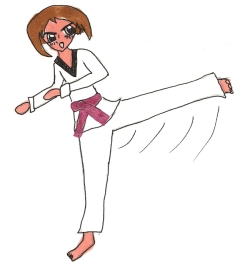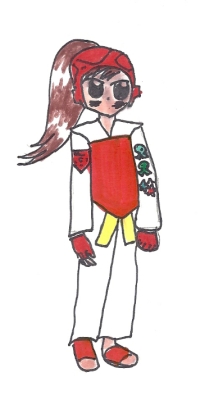Taekwondo Equipment and Uniforms
Taekwondo Equipment is your safety net for practicing properly. The Dobok (uniform) and sparring gear is usually the first thing you as a new student have to get used to.
 Red Belt, by Kathryn Lichlyter |
Dobok: The Taekwondo student or practitioner usually wears a traditionally styled uniform called a dobok. It consists of a loose-fitting shirt or top with loose pants, enabling the student to kick, punch, twist, and turn easily and freely. |
This uniform is traditionally white, although other colors have been introduced in some dojangs/schools. WTF-style uniforms have a v-neck that may be black (or another color), while ITF students usually wear the jacket style that crosses over the chest.
The belt is generally made of thick fabric. The rank of the student is indicated by the color of the belt, from white to black belt. Check out the belt system info page to learn more about the ranks themselves. Each belt signifies a development level. The belt is traditionally worn double-wrapped around the student and tied with a "fortune cookie" knot in the front.
Most schools recommend that all students wear proper exercise undergarments beneath the uniform. Women are usually required to wear a t-shirt or similar upper body garment under the uniform as well.
All students are expected to be in full uniform at the beginning of class. As you work out, your uniform and belt may need to be adjusted. Turn away from the flags (or the front of the classroom) and your instructor before you fix your dobok.
All jewelry should be removed, except for a plain wedding band as permitted by your instructor. Students with long hair tie it back to keep it from flying into their faces or eyes during the workout.
Students who wear glasses or contacts remove them before sparring or other impact training.
Injured students who work out with such supports as ankle or knee braces must have the equipment approved by a doctor and their instructor before participating.
All students must trim their toenails and fingernails to avoid accidentally scratching themselves or others.
Sparring Gear:
Sparring gear is designed to be lightweight – sturdy enough to absorb the impact from a kick or punch but light enough to allow the participant to move and kick freely as needed. (However, being hit full force with a heavyweight's round house
kick in the chest or head is still not recommended.) And don't forget to have a bag to hold all your gear when you’re traveling to and from class!
|
For WTF/Olympic style sparring: Each student or competitor must wear several important pieces of equipment: a chest protector (called a hogu), a helmet or similar headgear, shin guards, forearm guards, a groin protector (for both males and females), and a mouthpiece. Many dojangs also require foot or instep pads and gloves. Knee and elbow pads are optional, but are allowed under WTF rules. The hogu (chest protector) should cover your entire torso. Since the WTF rules allow for points to be scored to the back, except for the spinal cord, your chest protector should wrap almost entirely around your body. |
 "Sparring Gear On" by Kathryn Lichlyter |
Some students may have to work with electronic chest protectors that score points. This may not be available at all tournaments or dojangs, but as the technology gets better and better it may become standard.
Speaking of electronic equipment, special foot pads (or socks) and gloves may also be required for students wishing to compete. Make sure you discuss gear requirements with your instructor before you make purchases.
Here’s a personal note: When I began sparring, the equipment was quite different. The first chest protector I owned must have been stuffed with heavy cotton. It was heavy, and you felt kicks fairly easily. The next generation of chest protectors had hard foam insides, but the gaps both below and between the foam sections were, I quickly learned, motivation not to get hit. Today, the student-level chest protectors that my girls and I wear are thicker but lighter. They protect more of the body and are easier to maneuver in than any I have seen before. I had absolutely no problem letting my 5-year-old "gear up" and head out for her first sparring lesson; she literally didn't feel it when a 5 year old boy tagged her once (lightly but noticeably).
The headgear has also improved vastly. Today’s version is usually made with thick, impact-resistant foam, and is capable of reducing moderate blows to the head. HOWEVER, don’t try to test this out. Being kicked in the head for any reason isn't a good thing!
Follow the size recommendations of your instructor or school administrator. Your instructor may recommend different gear for different students. You may be allowed to purchase your gear from an outside source (it may be less expensive, or you may have acquired used gear from a friend or family member), but make sure that it is approved for the style of sparring.
When it comes to gear, smaller is not always better. In WTF-style sparring, the target area goes from the top of the hip bone up to the collar bone. Wearing a smaller hogu to try to create a smaller target for your opponent to hit will not eliminate the fact that the parts of you left unprotected will still be legal targets. I observed one tournament at which the fighter wore a chest protector about two sizes too small; his opponent kicked him three times below the chest protector, but still above the hip, and did some serious damage!
Schools always recommend that you write your name on your gear, and wipe it down with a multi-surface cleaner once in a while to keep it from having that workout fragrance.
For ITF-Style Sparring:
Depending on your school, there may be sparring with no contact (as opposed to WTF/Olympic style, which is light to full contact, depending on your level).
You school will let you know what you need. Generally speaking, you will fight with sparring gloves that may resemble boxing gloves, foot protectors (which look like boots without soles), head gear, shin guards, a groin protector (for both males and females) and a mouth protector.
Whatever style of “armor” you need, remember that your pads are designed to help you. Wearing them is no guarantee that you will be safe from injury if you do not pay attention to your own actions and the actions of your sparring partner or opponent.
Weapons:
Your dojang may have some weapons training with numchucks, staffs, or other equipment. As this is not part of traditional Taekwondo, talk with your instructor.
Taekwondo Instructors and Schools: Link your school website to Taekwondo-guide.com as a resource for your students.